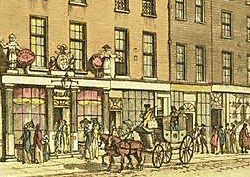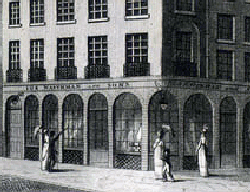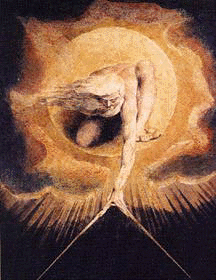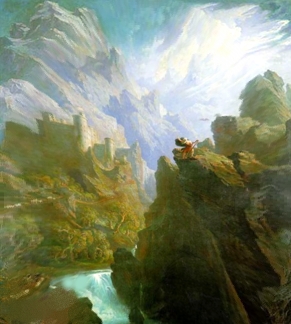Mary Shelley and the Regency
 Mary Shelley's youth spanned Regency England, the same period Jane Austen has made famous in her novels. In fact, Austen died in July of 1817, six months before Frankenstein was published.
Mary Shelley's youth spanned Regency England, the same period Jane Austen has made famous in her novels. In fact, Austen died in July of 1817, six months before Frankenstein was published.
Mary grew up in London. Her family was educated, but poor. Her mother, Mary Wollstonecraft, died giving birth. She was a writer who championed women's education and is recognized today as a seminal feminist voice. Mary's father, William Godwin, was part of a radical community that included middle class professionals, poets, journalists and artists. He was not part of the aristocracy, but as a writer and a political activist, he moved in very visible and influential circles. Godwin owned a children's bookstore and publishing company.
Percy Bysshe Shelley was the rebellious son of a baronet who at 19, sought out Godwin as a political mentor. By running off with 15 year-old Mary, Shelley appears to be the kind of character Austen painted as enticing, but ultimately untrustworthy. She would have approved even less of Lord Byron, who lived notoriously outside the bounds of proper society. These are the men that good women must avoid in Austen's books. And Mary, were she a character in Austen's world, would have fared little better. She would have been an outcast, both for her lack of connection, and for the scandalous nature of her life choices. After all, she ran off with a married man, got pregnant and had a child out of wedlock.
 In fact, Mary Shelley has no parallel in Austen's novels. None of them do. Mary's passionate nature, which led her to run away with Shelley, has representation, but in Austen's world, the young women who stray are thoughtless, and, as Mr. Bennett would say, silly. Mary Shelley was neither. She was a highly educated woman, a politically attuned writer, a reluctant rebel, and a courageous individual who lived in the company of two of the world's greatest poets.
In fact, Mary Shelley has no parallel in Austen's novels. None of them do. Mary's passionate nature, which led her to run away with Shelley, has representation, but in Austen's world, the young women who stray are thoughtless, and, as Mr. Bennett would say, silly. Mary Shelley was neither. She was a highly educated woman, a politically attuned writer, a reluctant rebel, and a courageous individual who lived in the company of two of the world's greatest poets.
Regency England refers to the time period (1811-1820) when England was ruled by the Prince Regent, King George III's son, George IV. The Prince Regent cared little for governing. He was arrogant, ignorant, and self-indulgent. He set an example of living fast and hard, which many of the wealthy emulated. He was not a popular ruler. Nevertheless, the Regency was a period of much innovation and change, a time of distinctive fashion, radical politics, and almost perpetual war. The entire period from 1795 to 1830 is often referred to as the Regency. And, as Jane Austen makes clear, it was a time when the rules governing women remained narrowly defined by the demands of a highly judgmental society.
The Romanticism of Mary Shelley
 Britain’s most noted Romantics span two generations of poets beginning with William Blake (1757-1827), William Wordsworth (1770-1850), and Samuel Taylor Coleridge (1772-1834); and followed by Lord Byron (1788-1824), Percy Bysshe Shelley (1793-1822), and John Keats (1795-1821). There is significant evidence to suggest that Mary Shelley knew every one of these men and all but Wordsworth and Keats make an appearance in Requiem.
Britain’s most noted Romantics span two generations of poets beginning with William Blake (1757-1827), William Wordsworth (1770-1850), and Samuel Taylor Coleridge (1772-1834); and followed by Lord Byron (1788-1824), Percy Bysshe Shelley (1793-1822), and John Keats (1795-1821). There is significant evidence to suggest that Mary Shelley knew every one of these men and all but Wordsworth and Keats make an appearance in Requiem.
The literary designation of Romanticism is largely an invention of the twentieth century. The Romantics did not form an official school, nor did they announce or define themselves as a group. They did, however, share a common vision and they influenced one another. They were interconnected, bound by the fact they inhabited a troubled world.
Romantic literature has its roots in an aversion to war. The French Revolution began in 1789, and by 1793 the English and French were fighting. They fought violently for twelve years. Romanticism is preoccupied with issues of freedom, liberty, truth and justice. It centers itself in the transcendental nature of the imagination, which its authors believed had the possibility of lifting humanity out of cruelty, hopelessness, and despair.
 Romanticism looks to the universal, recognizing and emphasizing the interconnectedness of all life and centrality of relationship. Common themes include the significance of nature, the mythological past, the supernatural dimensions of consciousness and reality, the power of passion, and the necessity of freedom. Romanticism is progressive, mythic, spiritually inclined and, at least in the case of Lord Byron, wonderfully irreverent.
Romanticism looks to the universal, recognizing and emphasizing the interconnectedness of all life and centrality of relationship. Common themes include the significance of nature, the mythological past, the supernatural dimensions of consciousness and reality, the power of passion, and the necessity of freedom. Romanticism is progressive, mythic, spiritually inclined and, at least in the case of Lord Byron, wonderfully irreverent.
The nature of the feminine is also a Romantic theme. Women in Romantic literature tend to step outside the ordinary and risk the censure of society in order to live more creative and fulfilled lives. In the world of authorship, women sought to move away from the trivializing categorization of their gender, and stand equally beside the male writers of the day. They attempted to accomplish this by publishing anonymously, as Mary Shelley did.